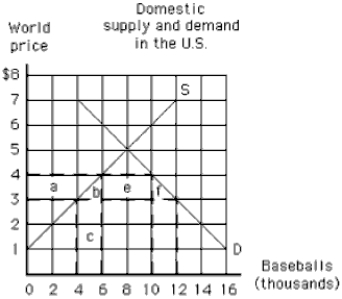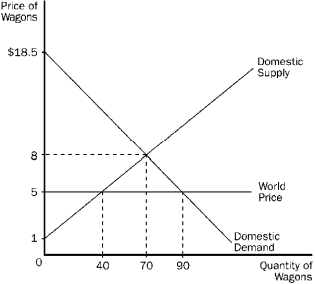A) decline because specialization is costly.
B) rise only when there is an accompanying decline in the total output of one's trading partners.
C) rise if a nation is a net exporter and fall if the nation is a net importer of goods and services.
D) increase since resources will be better directed toward their highest-valued use.
Correct Answer

verified
Correct Answer
verified
Multiple Choice
Figure 17-13
 -In Figure 17-13,if the world price of a baseball is $3 and a tariff of $1 per baseball is imposed in the United States,which area represents the amount of tariff revenue the United States government collects?
-In Figure 17-13,if the world price of a baseball is $3 and a tariff of $1 per baseball is imposed in the United States,which area represents the amount of tariff revenue the United States government collects?
A) a
B) b
C) c
D) f
E) e
Correct Answer

verified
Correct Answer
verified
Multiple Choice
The following table indicates the production possibilities of food and clothing per worker day in the United States and South Korea.
 Which of the following is true?
Which of the following is true?
A) Mutual gains from trade could be realized if the United States specialized in clothing production and South Korea in production of food.
B) South Korean workers are the low-cost producers of clothing.
C) Mutual gains could be realized if the United States specialized in producing food and South Korea in producing clothing.
D) U.S.workers are the high-cost producers of clothing.
Correct Answer

verified
Correct Answer
verified
Multiple Choice
Opportunity costs differ among nations primarily because
A) nations employ different currencies.
B) nations have different endowments of land,labor skills,capital,and technology.
C) nations have different political institutions.
D) work-leisure preferences vary considerably from one nation to another.
Correct Answer

verified
Correct Answer
verified
Multiple Choice
If the United States imposes an import quota on clothing,U.S.imports
A) increase,exports increase,and U.S.net exports are unchanged.
B) increase,exports decrease,and U.S.net exports increase.
C) decrease,exports increase,and U.S.net exports decrease.
D) decrease,exports decrease,and U.S.net exports are unchanged.
Correct Answer

verified
Correct Answer
verified
Multiple Choice
Figure 17-8
 -Refer to Figure 17-8.If this country allows free trade in wagons,
-Refer to Figure 17-8.If this country allows free trade in wagons,
A) consumers will gain and producers will lose.
B) consumers will lose and producers will gain.
C) both consumers and producers will gain.
D) both consumers and producers will lose.
Correct Answer

verified
Correct Answer
verified
Multiple Choice
Figure 17-13
 -In Figure 17-13,if the world price of a baseball is $3 and a tariff of $1 per baseball is imposed in the United States,how much tariff revenue will the United States government collect?
-In Figure 17-13,if the world price of a baseball is $3 and a tariff of $1 per baseball is imposed in the United States,how much tariff revenue will the United States government collect?
A) $4,000
B) $16,000
C) $20,000
D) $24,000
E) $48,000
Correct Answer

verified
Correct Answer
verified
Multiple Choice
Figure 17-13
 -In Figure 17-13,if the world price of a baseball is $3 and a tariff of $1 per baseball is imposed in the United States,which area represents the United States' net loss as a result of the tariff?
-In Figure 17-13,if the world price of a baseball is $3 and a tariff of $1 per baseball is imposed in the United States,which area represents the United States' net loss as a result of the tariff?
A) a + b + c + e
B) b + c + e
C) b + c
D) c + e
E) b + f
Correct Answer

verified
Correct Answer
verified
Multiple Choice
As a result of a tariff on imports,
A) imports will fall,exports will fall,and total output will decline.
B) imports will fall,exports will rise,and total output will decline.
C) imports will rise,exports will fall,and total output will expand.
D) imports will rise,exports will rise,and total output will expand.
Correct Answer

verified
Correct Answer
verified
Multiple Choice
Which of the following is a partially valid economic argument for restricting free trade?
A) Restrictions on foreign trade will increase employment and permanently reduce unemployment.
B) Infant industries may need temporary protection to develop and gain productive efficiency.
C) A nation needs to protect its national defense;hence,it should restrict some products that threaten an industry considered vital to its defense.
D) Both b and c are correct.
Correct Answer

verified
Correct Answer
verified
Multiple Choice
Fixing exchange rates and limiting the convertibility of currency will
A) improve international trade.
B) increase the ability of people to gain from specialization.
C) lead to black markets and less trade.
D) increase productivity and living standards.
Correct Answer

verified
Correct Answer
verified
Multiple Choice
A basic problem with the infant-industry argument is that
A) most industries need protection when they are mature,not when they are first established.
B) the amount of the tariff is unlikely to have much impact on the success of an infant industry.
C) political pressure will likely prevent the withdrawal of the tariff when the industry matures.
D) domestic consumers will continue to buy the foreign products anyway,regardless of the tariff.
Correct Answer

verified
Correct Answer
verified
Multiple Choice
Suppose the Swiss government subsidized its watch-making industry,enabling Swiss producers to undersell foreign watch producers.The law of comparative advantage indicates that watch-importing nations would best take advantage of the Swiss subsidization policy by
A) setting a tariff high enough to just offset the subsidy granted to the Swiss watch-making industry.
B) setting a declining quota on the import of Swiss watches such that the nation's domestic watch-making industry would continue to grow at the same rate as the rest of the economy.
C) setting a tariff such that the prices of Swiss and domestic watches to the consumer are equal.
D) gladly accepting the subsidy of the Swiss government,making the appropriate adjustment for the resources temporarily displaced from the domestic watch-making industry.
Correct Answer

verified
Correct Answer
verified
Multiple Choice
Opening trade between two nations would
A) shift their production possibilities curves outward.
B) shift their production possibilities curves inward.
C) leave the production possibilities unchanged and increase their consumption possibilities.
D) leave the production possibilities unchanged and decreased their consumption possibilities.
Correct Answer

verified
Correct Answer
verified
Multiple Choice
If the United States unilaterally removed all of its trade restrictions and moved toward a policy of free trade,international trade theory indicates that
A) U.S.residents would gain,but people in other countries would be worse off.
B) people in other countries would gain,but U.S.residents would be worse off.
C) both U.S.residents and people in other countries would be able to achieve higher income levels.
D) the average income level would be lower in both the United States and other countries.
Correct Answer

verified
Correct Answer
verified
Multiple Choice
Which of the following arguments in support of trade restrictions limiting U.S.dependence on foreign suppliers of petroleum and aircraft is most valid when applied to the United States?
A) the national defense argument
B) the industrial diversity argument
C) the comparative advantage argument
D) the infant-industry argument
Correct Answer

verified
Correct Answer
verified
Multiple Choice
Which of the following is true?
A) In recent decades,the volume of U.S.international trade has been declining as a share of the economy.
B) Most of the textile products produced in the United States are exported abroad.
C) The volume of U.S.trade with Canada is larger than for any other country.
D) If one party to an international exchange gains,the other party must lose a similar amount.
Correct Answer

verified
Correct Answer
verified
Multiple Choice
If a foreign supplier sells a good in another country at a cheaper price than it sells the good in its home market,the
A) foreign supplier will gain a monopoly in the foreign market.
B) consumers in the receiving country will be harmed by the dumping of the good into its domestic market.
C) consumers in the receiving country can gain from buying the foreign-produced good if it is cheaper than the cost of producing the good domestically.
D) usual implications of the law of comparative advantage with trade restrictions do not hold in this case,particularly if the low-cost supplier is subsidized by a foreign government.
Correct Answer

verified
Correct Answer
verified
Multiple Choice
Which of the following is true?
A) In recent decades,the volume of U.S.international trade has been increasing as a share of the economy.
B) As transportation costs decline,the volume of international trade will also tend to decline.
C) Most international trade is between the governments of different nations.
D) If one party to an international exchange gains,the other party must lose a similar amount.
Correct Answer

verified
Correct Answer
verified
Multiple Choice
In 2002,President Bush enacted a 30 percent tariff on imported steel.The primary beneficiaries of this tariff were
A) U.S.steel companies and employees.
B) U.S.automobile companies and employees.
C) foreign steel companies.
D) foreign steel workers.
E) both a and b above.
Correct Answer

verified
Correct Answer
verified
Showing 41 - 60 of 222
Related Exams